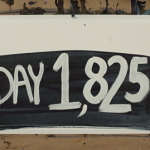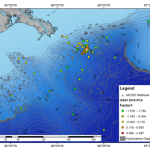Last week I was in Florida (again) to attend a Deepwater Horizon Principal Investigator conference, sponsored by the National Science and Technology Council’s Joint Subcommittee on Ocean Science and Technology (JSOST). Life is so hard when your work takes you to all these tropical oases.
It was a big meeting of academics who were awarded NSF RAPID grants (=me), where we mingled with government big wigs and spill responders.
This was my first in-depth glimpse into the state of oil spill science, and I came out of the meeting with a few important observations:
- Initially, scientific effort surrounding the DH spill was extremely unorganized, but now it seems to be slowly getting better. There are a lot of different parties involved (NOAA, Coast Guard, NRDA contractors, independent academics), and this led to redundancy that could have been avoided with better organization—for instance, cases where two ships at essentially the same location were collecting exactly the same type of samples. Ship time is very expensive and precious, and I sort of cringe at the thought of lost opportunity—the scientific audience agreed that we need to maximize these sampling efforts to get as much coverage as possible, in terms of geographic sites as well as type of samples collected.
- Scientists were (and still are) having difficulty getting samples, even in cases where they sent repeated requests. Some academics have petitioned for samples of drilling mud and DH oil—both of which are needed to establish crucial baselines for geochemical analyses—but have so far been unable to obtain them, stunting scientific investigation. Apparently we shouldn’t be having this problem, but we are, and I’m still unsure as to whether this is an organizational problem (which is very likely) or attempts to stifle science. As someone who works in New Hampshire (not exactly a Gulf State), I feel isolated from cruise opportunities and extra samples. We know cruises are going out constantly, but we’re unsure about who to contact no one is being forthcoming with this crucial information. I will be shameless about begging for samples, but I need to know where to grovel!
- I’m astounded by how many projects are going on. I was dumbfounded and extremely pleased at the same time; dumbfounded because I wouldn’t have known there was anyone to collaborate with if I didn’t attend this meeting in person, and pleased because the scientific effort is so strong (but definitely needs coordination, see points 1 and 2).
- There are so many databases and resources related to the oil spill that it is completely overwhelming. I don’t even know where to look (and I’m dealing with the topic every day), so I can’t even imagine your average non-scientist trying to find relevant information. For those of you interested in the RAPID and other Gulf projects going on, a good place to start is at gulfseagrant.org/oilspill/database. This site also has a good page with links to information about dispersants, seafood safety, human health, and research/monitoring updates.
- The oil went as far East as Panama City, FL, which is something I really wouldn’t have known if I hadn’t a) visited the beach myself or b) been at this meeting. The NOAA presentations put up this wonderful composite map of the oil sheen, and I’ve just spent half an hour looking for this graphic on all the Deepwater Horizon websites. This is what I mean about overabundance of resources (see point 4)—I still can’t find it, but if you look at this map then basically oil has hit everywhere in red (the 81-100% probability in the legend), including a good chunk of the Florida panhandle.
I’m off to work on 38382038409 Gulf sample extractions and PCRs, but soon I’ll post a science update from the meeting—stay tuned!






5 Replies to “The state of Gulf spill science–my view”
Comments are closed.